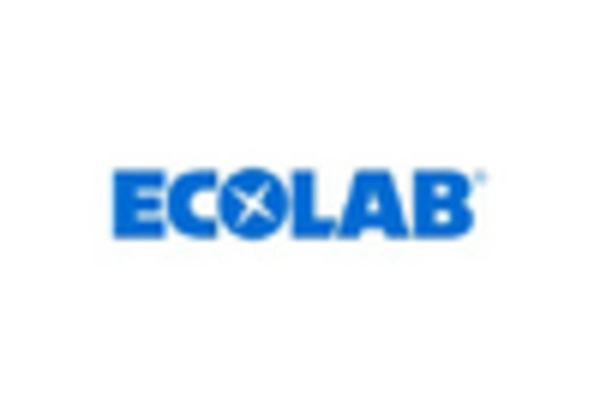Regulatory Pressures
Regulatory pressures regarding water quality and environmental protection are significant drivers for the Process Chemicals For Water Treatment Market. Governments and regulatory bodies worldwide are implementing stringent guidelines to ensure safe drinking water and minimize industrial discharge impacts. Compliance with these regulations often necessitates the use of specialized process chemicals that can effectively treat and purify water. The increasing focus on environmental sustainability and public health is likely to drive investments in water treatment technologies, thereby boosting the demand for process chemicals. As regulations become more rigorous, the market for these chemicals is expected to expand, reflecting the need for compliance-driven solutions.
Rising Water Scarcity
The increasing scarcity of freshwater resources is a pressing concern, driving the demand for the Process Chemicals For Water Treatment Market. As populations grow and industrial activities expand, the strain on available water sources intensifies. This situation compels municipalities and industries to invest in advanced water treatment solutions, including process chemicals that enhance purification and recycling efforts. According to recent estimates, the global water scarcity could affect over 2 billion people by 2025, necessitating the adoption of effective water treatment chemicals. The Process Chemicals For Water Treatment Market is thus positioned to experience substantial growth as stakeholders seek to address these challenges through innovative chemical solutions.
Technological Innovations
Technological innovations in water treatment processes are reshaping the Process Chemicals For Water Treatment Market. Advancements in chemical formulations and application techniques enhance the efficiency and effectiveness of water treatment solutions. For instance, the development of eco-friendly and biodegradable chemicals is gaining traction, aligning with the increasing emphasis on sustainability. Furthermore, automation and smart technologies in water treatment facilities are optimizing chemical usage, reducing waste, and improving overall operational efficiency. The integration of these technologies is expected to propel the market forward, as stakeholders seek to leverage innovative solutions to meet evolving water treatment demands.
Growing Awareness of Water Quality
The growing awareness of water quality and its implications for health and the environment is a crucial driver for the Process Chemicals For Water Treatment Market. Consumers and industries alike are becoming increasingly conscious of the importance of clean water, leading to heightened demand for effective water treatment solutions. This awareness is prompting investments in advanced process chemicals that can address various contaminants and improve water safety. Market Research Future indicates that the demand for water treatment chemicals is projected to rise significantly, driven by both consumer preferences and regulatory requirements. As stakeholders prioritize water quality, the Process Chemicals For Water Treatment Market is likely to witness robust growth.
Industrial Growth and Urbanization
Rapid industrial growth and urbanization are pivotal factors influencing the Process Chemicals For Water Treatment Market. As urban areas expand, the demand for clean water escalates, prompting industries to adopt sophisticated water treatment processes. The industrial sector, particularly manufacturing and energy, is a significant contributor to water pollution, necessitating the use of process chemicals to ensure compliance with environmental regulations. Reports indicate that the industrial water treatment chemicals market is projected to grow at a CAGR of approximately 6% over the next few years. This trend underscores the critical role of process chemicals in maintaining water quality and supporting sustainable industrial practices.


















Leave a Comment